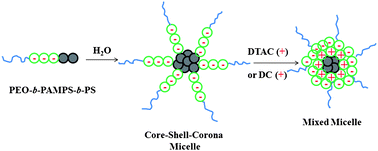Micelle formation of poly(ethylene oxide-b-sodium 2-(acrylamido)-2-methyl-1-propane sulfonate-b-styrene) and its interaction with dodecyl trimethyl ammonium chloride and dibucaine†
Abstract
Micelles of a new

* Corresponding authors
a
Department of Chemistry, Faculty of Science and Engineering, Saga University, 1 Honjo-machi, Saga, Japan
E-mail:
nakashik@cc.saga-u.ac.jp
b Department of Materials Science and Chemistry, University of Hyogo, 2167 Shosha, Himeji, Japan
Micelles of a new

 Please wait while we load your content...
Something went wrong. Try again?
Please wait while we load your content...
Something went wrong. Try again?
B. P. Bastakoti, S. Guragain, A. Yoneda, Y. Yokoyama, S. Yusa and K. Nakashima, Polym. Chem., 2010, 1, 347 DOI: 10.1039/B9PY00231F
To request permission to reproduce material from this article, please go to the Copyright Clearance Center request page.
If you are an author contributing to an RSC publication, you do not need to request permission provided correct acknowledgement is given.
If you are the author of this article, you do not need to request permission to reproduce figures and diagrams provided correct acknowledgement is given. If you want to reproduce the whole article in a third-party publication (excluding your thesis/dissertation for which permission is not required) please go to the Copyright Clearance Center request page.
Read more about how to correctly acknowledge RSC content.
 Fetching data from CrossRef.
Fetching data from CrossRef.
This may take some time to load.
Loading related content
